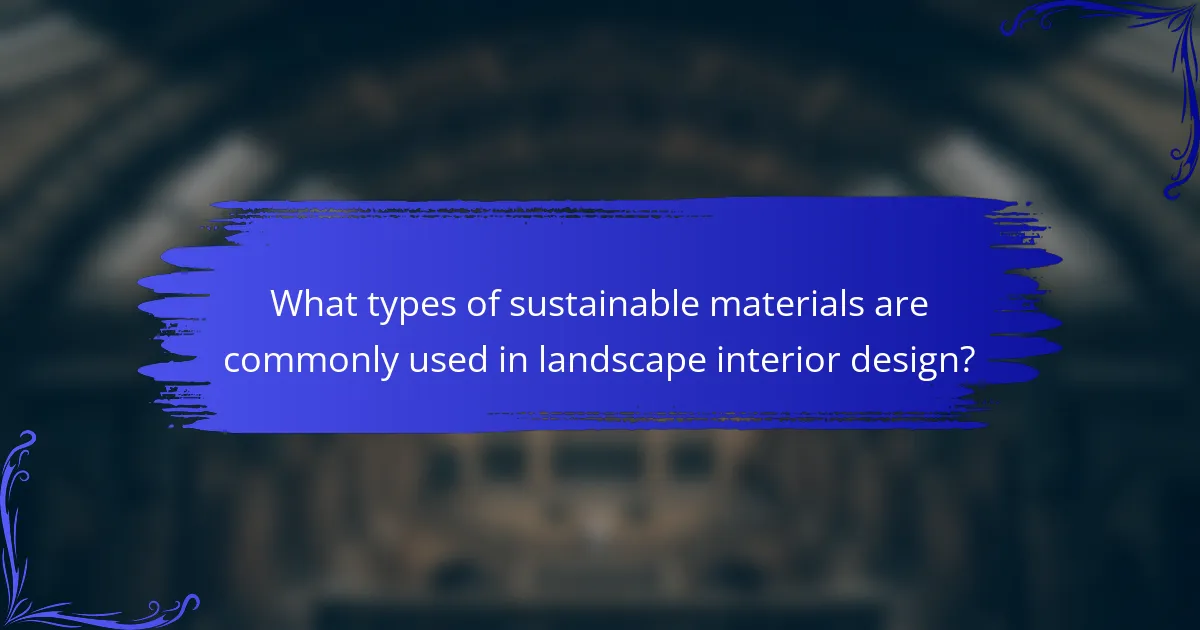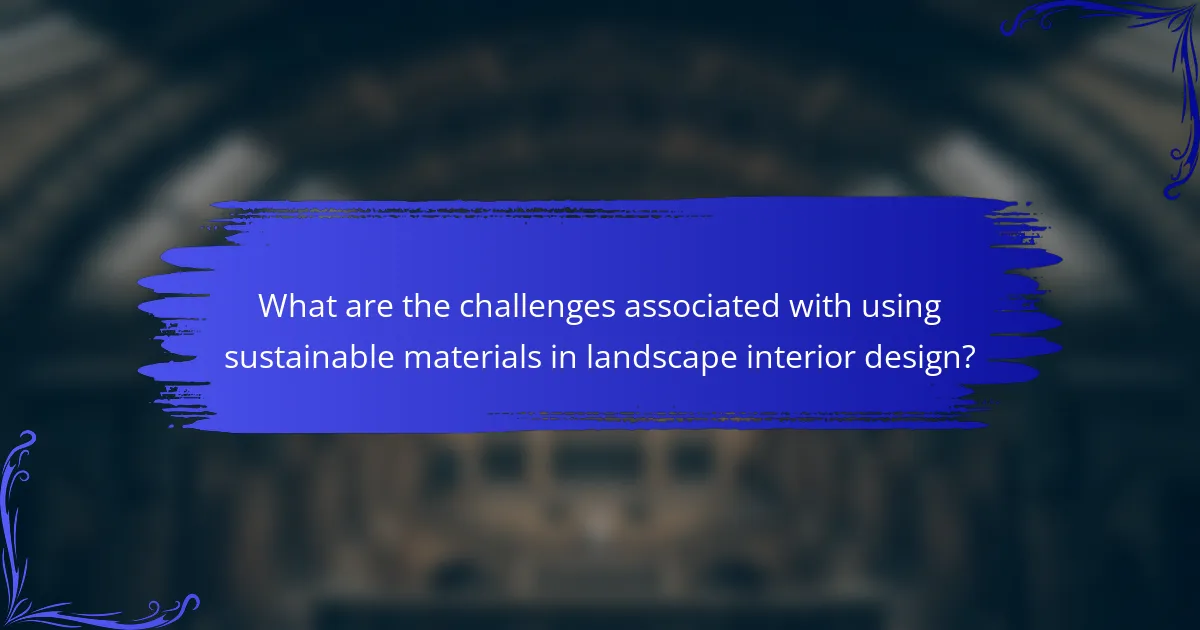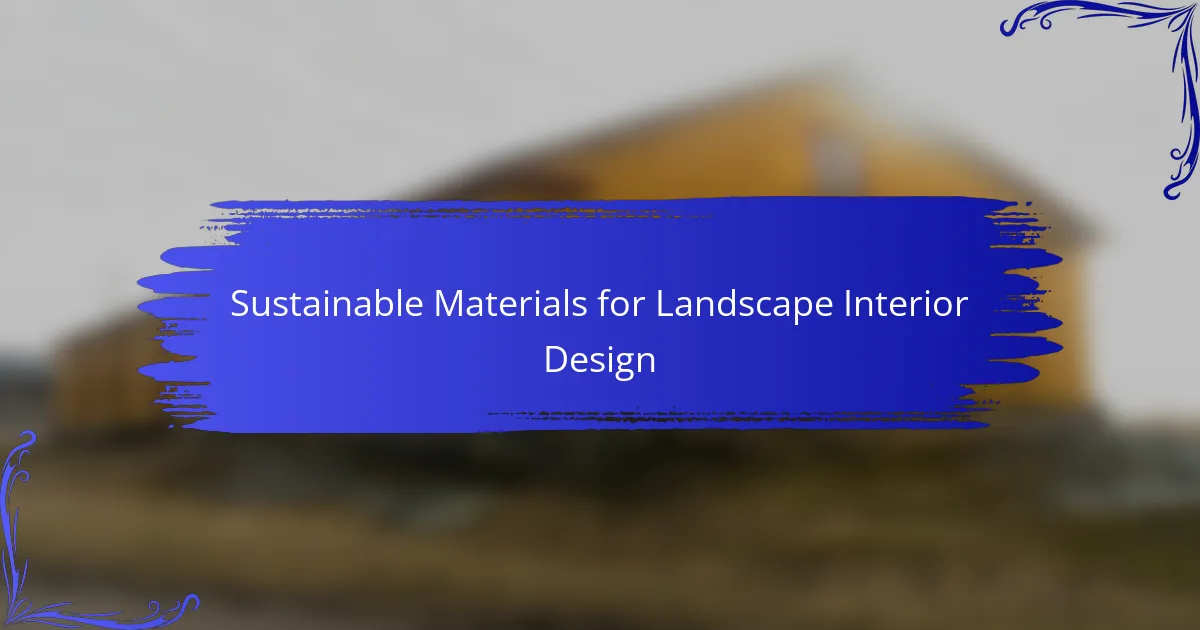Sustainable materials for landscape interior design refer to eco-friendly resources that are utilized to create functional and visually appealing spaces while minimizing environmental impact. Common examples include reclaimed wood, bamboo, recycled metals, and natural stones, all of which contribute to healthier indoor environments and support sustainable design practices. The article examines the benefits of these materials, such as reducing carbon footprints and enhancing aesthetic appeal, while also addressing challenges like higher costs, limited availability, and regulatory hurdles that can affect their integration into design projects. Overall, the discussion highlights the importance of sustainable materials in promoting biodiversity and reducing waste in landscape interior design.

What are Sustainable Materials for Landscape Interior Design?
Sustainable materials for landscape interior design are eco-friendly resources used to create functional and aesthetically pleasing spaces. These materials minimize environmental impact while promoting biodiversity and reducing waste. Examples include reclaimed wood, which repurposes existing timber, and bamboo, known for its rapid growth and renewability. Additionally, recycled metals and glass can be utilized for decorative elements. Natural stones are also sustainable options, as they require less processing. Using these materials contributes to healthier indoor environments and supports sustainable practices in design. Studies show that incorporating sustainable materials can reduce the carbon footprint of construction projects significantly.
How do sustainable materials impact landscape interior design?
Sustainable materials significantly enhance landscape interior design by promoting environmental responsibility. They reduce ecological footprints through the use of renewable resources. Incorporating materials like bamboo, reclaimed wood, and recycled metals minimizes waste. Sustainable materials often require less energy for production, leading to lower greenhouse gas emissions. Their durability contributes to long-lasting designs, reducing the need for frequent replacements. Additionally, they can improve indoor air quality by reducing harmful emissions. Studies show that using sustainable materials can increase property value by up to 15%. This integration fosters a connection between nature and design, creating aesthetically pleasing and eco-friendly spaces.
What defines a material as sustainable in this context?
A material is defined as sustainable in this context if it minimizes environmental impact throughout its life cycle. This includes sourcing, production, use, and disposal. Sustainable materials often come from renewable resources. They should also be non-toxic and safe for both human health and the ecosystem. Additionally, they should promote energy efficiency during their use. The use of recycled or upcycled materials also qualifies as sustainable. According to the U.S. Green Building Council, sustainable materials contribute to reducing waste and conserving resources.
How are sustainable materials sourced for landscape design?
Sustainable materials for landscape design are sourced through responsible practices that prioritize environmental health. This includes selecting materials that are renewable, recycled, or locally sourced. For instance, reclaimed wood and recycled metals reduce waste and the need for new resources. Local sourcing minimizes transportation emissions and supports regional economies. Sustainable sourcing also involves evaluating the lifecycle impact of materials. This ensures that they are durable and have low environmental footprints. Certifications, like FSC for wood, help identify sustainably sourced products. Research shows that using sustainable materials can significantly reduce carbon footprints in landscape projects.
What are the benefits of using sustainable materials in landscape interior design?
Using sustainable materials in landscape interior design reduces environmental impact and promotes ecological balance. These materials often have a lower carbon footprint compared to conventional options. Sustainable materials can enhance energy efficiency in design, leading to reduced utility costs. They also contribute to healthier indoor air quality by minimizing harmful emissions. Additionally, sustainable materials often utilize renewable resources, promoting long-term sustainability. Research indicates that using recycled materials can significantly decrease waste in landfills. Furthermore, sustainable designs can increase property value, appealing to environmentally conscious buyers. Overall, the integration of sustainable materials fosters a harmonious relationship between design and nature.
How do sustainable materials contribute to environmental conservation?
Sustainable materials contribute to environmental conservation by reducing resource depletion and waste. They are often sourced from renewable resources, which minimizes the impact on ecosystems. For example, bamboo grows rapidly and can be harvested without harming the environment. Sustainable materials also require less energy to produce compared to conventional materials. This results in lower greenhouse gas emissions. Additionally, many sustainable materials are biodegradable or recyclable, reducing landfill waste. The use of such materials promotes a circular economy, where resources are reused and repurposed. Studies show that using sustainable materials can significantly lower a project’s carbon footprint.
What economic advantages do sustainable materials offer?
Sustainable materials offer significant economic advantages, including cost savings and increased efficiency. They often have lower lifecycle costs due to reduced energy consumption during production and use. For instance, using bamboo instead of hardwood can save up to 30% in material costs. Additionally, sustainable materials can enhance property value. Homes built with eco-friendly materials often sell for 10-20% more than conventional homes. Furthermore, they can qualify for tax incentives and rebates, reducing upfront expenses. Overall, investing in sustainable materials leads to long-term financial benefits for both consumers and businesses.

What types of sustainable materials are commonly used in landscape interior design?
Sustainable materials commonly used in landscape interior design include reclaimed wood, bamboo, and recycled metal. Reclaimed wood reduces waste by repurposing old timber. Bamboo is a fast-growing grass, making it a renewable resource. Recycled metal, often from old structures, minimizes the need for new raw materials. Other materials include natural stone, which is durable and abundant, and permeable paving, which helps manage stormwater. These materials contribute to eco-friendly design while enhancing aesthetic appeal.
What are the main categories of sustainable materials?
The main categories of sustainable materials include renewable materials, recycled materials, and biodegradable materials. Renewable materials are sourced from resources that can regenerate naturally, such as bamboo and cork. Recycled materials are made from repurposed waste, reducing the need for new raw materials; examples include recycled metal and glass. Biodegradable materials break down naturally over time, minimizing environmental impact; common examples are organic textiles and certain plastics. These categories support eco-friendly practices in landscape interior design, promoting sustainability and resource conservation.
How do natural materials differ from recycled materials in landscape design?
Natural materials are sourced directly from nature, while recycled materials are repurposed from waste products. Natural materials include wood, stone, and soil, which provide organic aesthetics and support local ecosystems. Recycled materials often consist of reclaimed wood, recycled plastic, or metal, contributing to waste reduction and sustainability. The durability of natural materials can vary, while recycled materials are engineered for strength and longevity. Natural materials can enhance biodiversity, whereas recycled materials may lack the same ecological benefits. In landscape design, the choice between these materials impacts environmental sustainability, aesthetic appeal, and resource conservation.
What innovative materials are emerging in the sustainable design space?
Innovative materials emerging in the sustainable design space include mycelium, recycled plastics, and bamboo. Mycelium is a biodegradable material derived from fungal networks. It serves as an alternative to traditional materials in construction and packaging. Recycled plastics are being repurposed into products like furniture and insulation. This reduces waste and conserves resources. Bamboo is a fast-growing plant that offers strength and flexibility. It is increasingly used in flooring and furniture. These materials contribute to a circular economy and minimize environmental impact. The use of such sustainable materials is supported by research indicating their effectiveness in reducing carbon footprints.
How can the choice of sustainable materials enhance aesthetic appeal?
The choice of sustainable materials can significantly enhance aesthetic appeal by offering unique textures and colors. Sustainable materials, such as reclaimed wood or bamboo, bring natural beauty to designs. These materials often have distinctive grain patterns that add visual interest. Additionally, eco-friendly materials like recycled glass can introduce vibrant hues and reflective qualities. The use of natural fibers, such as jute or hemp, provides warmth and a tactile experience. Studies show that spaces designed with sustainable materials promote a sense of well-being and connection to nature. This connection can lead to more inviting and harmonious environments. Overall, sustainable materials contribute both functionally and aesthetically to landscape interior design.
What role does texture play in selecting sustainable materials?
Texture plays a crucial role in selecting sustainable materials. It influences both aesthetic appeal and functional performance. Textured surfaces can enhance grip and safety in various applications. They also contribute to the sensory experience of a space. Sustainable materials often utilize natural textures that promote ecological harmony. For example, reclaimed wood features unique textures that tell a story while reducing waste. Additionally, texture can affect the durability and maintenance of materials. Rough textures may hide wear better than smooth surfaces, extending the life of the material. Overall, texture is a key factor in the effectiveness and sustainability of materials used in landscape interior design.
How can color selection influence the overall design with sustainable materials?
Color selection significantly influences the overall design when using sustainable materials. It affects aesthetics, mood, and perceived quality. Different colors can enhance or diminish the natural qualities of sustainable materials. For instance, earthy tones often complement wood and stone, promoting a harmonious look. Bright colors can add vibrancy, making spaces feel more inviting.
Research indicates that color psychology plays a vital role in design. A study published in the Journal of Environmental Psychology shows that color can impact emotional responses and perceptions of space. Sustainable materials can benefit from thoughtful color choices to reinforce their eco-friendly attributes.
Moreover, color can influence the usability of a space. Lighter colors can make small areas appear larger, while darker shades can create intimacy. Effective color selection ensures that sustainable materials are showcased to their best advantage, enhancing the overall design impact.

What are the challenges associated with using sustainable materials in landscape interior design?
The challenges associated with using sustainable materials in landscape interior design include higher costs and limited availability. Sustainable materials often require more investment upfront compared to conventional options. This can deter designers and clients from choosing them. Additionally, sourcing sustainable materials can be difficult. Many suppliers may not offer a wide range of eco-friendly options. There is also a lack of standardization in what qualifies as sustainable. This can lead to confusion and inconsistency in material selection. Furthermore, performance and durability can be concerns. Some sustainable materials may not withstand environmental conditions as well as traditional materials. Lastly, there may be regulatory hurdles. Compliance with building codes and standards can complicate the integration of sustainable materials.
What are common misconceptions about sustainable materials?
Common misconceptions about sustainable materials include the belief that they are always more expensive. While some sustainable materials can be costly, many options are competitively priced. Another misconception is that all sustainable materials are of lower quality. In reality, many sustainable materials, such as bamboo and reclaimed wood, are durable and high-performing. Some people think that sustainable materials are limited to specific types, like recycled plastics or organic fabrics. However, sustainable materials encompass a wide range of options, including natural stone and sustainably harvested timber. Additionally, there is a belief that using sustainable materials requires significant lifestyle changes. In fact, many sustainable materials can be seamlessly integrated into existing designs without major alterations. Lastly, a common misconception is that sustainable materials are not aesthetically pleasing. Many sustainable options offer unique and attractive designs that can enhance any space.
How can designers overcome the perceived limitations of sustainable materials?
Designers can overcome the perceived limitations of sustainable materials by educating stakeholders on their benefits. This education can include workshops and presentations. Designers should showcase successful projects that utilize sustainable materials effectively. They can also collaborate with manufacturers to improve material performance and aesthetics. Testing and prototyping can demonstrate the viability of these materials in real-world applications. By highlighting certifications and standards, designers can build trust in sustainable options. Engaging in open dialogue with clients can address concerns and misconceptions. Lastly, designers can advocate for policy changes that support sustainable material use in the industry.
What are the logistical challenges in sourcing sustainable materials?
Sourcing sustainable materials faces several logistical challenges. Transportation costs can be high due to the distance between suppliers and manufacturers. Limited availability of sustainable materials can lead to supply chain disruptions. Quality assurance is difficult, as sustainable materials may vary in performance. Storage requirements for certain materials can complicate inventory management. Compliance with regulations adds complexity to sourcing processes. Additionally, fluctuating demand for sustainable products can create unpredictability in sourcing. These challenges highlight the need for strategic planning in the procurement of sustainable materials.
How do regulations affect the use of sustainable materials in landscape design?
Regulations significantly influence the use of sustainable materials in landscape design. They establish standards for environmental protection and resource management. Compliance with these regulations can encourage the adoption of eco-friendly materials. For instance, building codes may require the use of recycled or renewable resources. Additionally, incentives may be provided for projects that utilize sustainable practices. Local governments often promote sustainability through zoning laws and permitting processes. These regulations can lead to increased awareness and demand for sustainable materials. Ultimately, regulations shape industry practices and drive innovation in sustainable landscape design.
What certifications should designers look for in sustainable materials?
Designers should look for certifications such as FSC, Cradle to Cradle, and GREENGUARD when selecting sustainable materials. The Forest Stewardship Council (FSC) certification ensures that wood products come from responsibly managed forests. Cradle to Cradle certification assesses a product’s safety and sustainability across its entire life cycle. GREENGUARD certification indicates that materials have low chemical emissions, contributing to healthier indoor air quality. These certifications provide assurance that materials meet rigorous environmental and health standards.
How do building codes influence material choices in landscape design?
Building codes significantly influence material choices in landscape design by establishing safety, durability, and environmental standards. These codes dictate the types of materials that can be used based on their performance in various conditions. For instance, codes may require specific fire-resistant materials in certain areas. Additionally, they can mandate the use of sustainable materials to promote environmental responsibility. Compliance with these regulations ensures that designs are not only aesthetically pleasing but also safe and sustainable. Furthermore, local building codes often reflect regional climate considerations, affecting material selection for durability and maintenance. Overall, adherence to building codes shapes the landscape design process, ensuring that materials meet essential safety and sustainability criteria.
What best practices should designers follow when selecting sustainable materials?
Designers should prioritize the life cycle assessment of materials when selecting sustainable options. This involves evaluating the environmental impact from extraction to disposal. They should choose materials that are renewable and sourced sustainably. Recycled materials are also a strong option, as they reduce waste and conserve resources. Designers should consider the durability of materials, as long-lasting products minimize the need for replacements. Local sourcing can reduce transportation emissions and support community economies. Additionally, designers should assess the toxicity of materials to ensure they are safe for both people and the environment. Finally, they should stay informed about new sustainable practices and innovations in material technology.
How can designers ensure the longevity of sustainable materials in their projects?
Designers can ensure the longevity of sustainable materials by selecting high-quality, durable options. These materials should withstand environmental stresses and wear over time. Proper maintenance strategies are essential for prolonging lifespan. Regular cleaning and care can prevent deterioration. Additionally, designers should consider the environmental conditions of the project site. Materials suited for specific climates will perform better and last longer. Using protective finishes can also enhance durability. Research shows that high-quality sustainable materials can reduce the need for replacements, thus promoting sustainability. For instance, studies indicate that well-chosen materials can last 20-30 years with proper care.
What strategies can be employed to balance sustainability with budget constraints?
Implementing cost-effective sustainable practices is essential for balancing sustainability with budget constraints. Prioritizing local materials reduces transportation costs and supports the local economy. Utilizing recycled or reclaimed materials minimizes waste and often lowers material costs. Investing in energy-efficient designs can lead to long-term savings on utility bills. Collaborating with suppliers for bulk purchasing can yield discounts and reduce costs. Incorporating low-maintenance plants can decrease ongoing care expenses. Conducting a lifecycle assessment helps identify the most cost-effective sustainable options. These strategies collectively enhance sustainability while adhering to budget limitations.
Sustainable materials for landscape interior design are eco-friendly resources that minimize environmental impact while enhancing aesthetic appeal. This article outlines the types of sustainable materials commonly used, such as reclaimed wood, bamboo, and recycled metals, and discusses their benefits, including reduced carbon footprints and improved indoor air quality. It also addresses the sourcing challenges, economic advantages, and the importance of certifications in ensuring sustainability. Additionally, the article examines how designers can select materials that balance sustainability with budget constraints while adhering to building codes and regulations.
